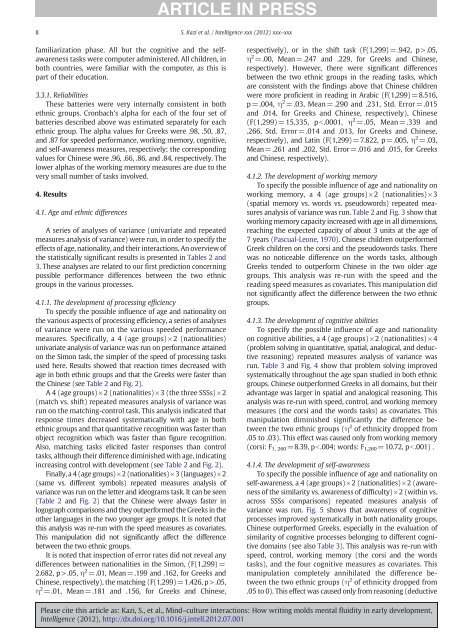Mindâculture interactions: How writing molds ... - ResearchGate
Mindâculture interactions: How writing molds ... - ResearchGate
Mindâculture interactions: How writing molds ... - ResearchGate
You also want an ePaper? Increase the reach of your titles
YUMPU automatically turns print PDFs into web optimized ePapers that Google loves.
8 S. Kazi et al. / Intelligence xxx (2012) xxx–xxxfamiliarization phase. All but the cognitive and the selfawarenesstasks were computer administered. All children, inboth countries, were familiar with the computer, as this ispart of their education.3.3.1. ReliabilitiesThese batteries were very internally consistent in bothethnic groups. Cronbach's alpha for each of the four set ofbatteries described above was estimated separately for eachethnic group. The alpha values for Greeks were .98, .50, .87,and .87 for speeded performance, working memory, cognitive,and self-awareness measures, respectively; the correspondingvalues for Chinese were .96, .66, .86, and .84, respectively. Thelower alphas of the working memory measures are due to thevery small number of tasks involved.4. Results4.1. Age and ethnic differencesA series of analyses of variance (univariate and repeatedmeasures analysis of variance) were run, in order to specify theeffects of age, nationality, and their <strong>interactions</strong>. An overview ofthe statistically significant results is presented in Tables 2 and3. These analyses are related to our first prediction concerningpossible performance differences between the two ethnicgroups in the various processes.4.1.1. The development of processing efficiencyTo specify the possible influence of age and nationality onthe various aspects of processing efficiency, a series of analysesof variance were run on the various speeded performancemeasures. Specifically, a 4 (age groups)×2 (nationalities)univariate analysis of variance was run on performance attainedon the Simon task, the simpler of the speed of processing tasksused here. Results showed that reaction times decreased withage in both ethnic groups and that the Greeks were faster thanthe Chinese (see Table 2 and Fig. 2).A 4 (age groups)×2 (nationalities)×3 (the three SSSs)×2(match vs. shift) repeated measures analysis of variance wasrun on the matching-control task. This analysis indicated thatresponse times decreased systematically with age in bothethnic groups and that quantitative recognition was faster thanobject recognition which was faster than figure recognition.Also, matching tasks elicited faster responses than controltasks, although their difference diminished with age, indicatingincreasing control with development (see Table 2 and Fig. 2).Finally, a 4 (age groups)×2 (nationalities)×3 (languages)×2(same vs. different symbols) repeated measures analysis ofvariance was run on the letter and ideograms task. It can be seen(Table 2 and Fig. 2) that the Chinese were always faster inlogograph comparisons and they outperformed the Greeks in theother languages in the two younger age groups. It is noted thatthis analysis was re-run with the speed measures as covariates.This manipulation did not significantly affect the differencebetween the two ethnic groups.It is noted that inspection of error rates did not reveal anydifferences between nationalities in the Simon, (F(1,299)=2.682, p>.05, η 2 =.01, Mean=.199 and .162, for Greeks andChinese, respectively), the matching (F(1,299)=1.426, p>.05,η 2 =.01, Mean=.181 and .156, for Greeks and Chinese,respectively), or in the shift task (F(1,299)=.942, p>.05,η 2 =.00, Mean=.247 and .229, for Greeks and Chinese,respectively). <strong>How</strong>ever, there were significant differencesbetween the two ethnic groups in the reading tasks, whichare consistent with the findings above that Chinese childrenwere more proficient in reading in Arabic (F(1,299)=8.516,p=.004, η 2 =.03, Mean=.290 and .231, Std. Error=.015and .014, for Greeks and Chinese, respectively), Chinese(F(1,299)=15.335, pb.0001, η 2 =.05, Mean=.339 and.266, Std. Error=.014 and .013, for Greeks and Chinese,respectively), and Latin (F(1,299)=7.822, p=.005, η 2 =.03,Mean=.261 and .202, Std. Error=.016 and .015, for Greeksand Chinese, respectively).4.1.2. The development of working memoryTo specify the possible influence of age and nationality onworking memory, a 4 (age groups)×2 (nationalities)×3(spatial memory vs. words vs. pseudowords) repeated measuresanalysis of variance was run. Table 2 and Fig. 3 show thatworking memory capacity increased with age in all dimensions,reaching the expected capacity of about 3 units at the age of7years(Pascual-Leone, 1970). Chinese children outperformedGreek children on the corsi and the pseudowords tasks. Therewas no noticeable difference on the words tasks, althoughGreeks tended to outperform Chinese in the two older agegroups. Τhis analysis was re-run with the speed and thereading speed measures as covariates. This manipulation didnot significantly affect the difference between the two ethnicgroups.4.1.3. The development of cognitive abilitiesTo specify the possible influence of age and nationalityon cognitive abilities, a 4 (age groups)×2 (nationalities) ×4(problem solving in quantitative, spatial, analogical, and deductivereasoning) repeated measures analysis of variance wasrun. Table 3 and Fig. 4 show that problem solving improvedsystematically throughout the age span studied in both ethnicgroups. Chinese outperformed Greeks in all domains, but theiradvantage was larger in spatial and analogical reasoning. Thisanalysis was re-run with speed, control, and working memorymeasures (the corsi and the words tasks) as covariates. Thismanipulation diminished significantly the difference betweenthe two ethnic groups (η 2 of ethnicity dropped from.05 to .03). This effect was caused only from working memory(corsi: F 1, 260 =8.39, pb.004; words: F 1,260 =10.72, pb.001) .4.1.4. The development of self-awarenessTo specify the possible influence of age and nationality onself-awareness, a 4 (age groups)×2 (nationalities)×2 (awarenessof the similarity vs. awareness of difficulty)×2 (within vs.across SSSs comparisons) repeated measures analysis ofvariance was run. Fig. 5 shows that awareness of cognitiveprocesses improved systematically in both nationality groups.Chinese outperformed Greeks, especially in the evaluation ofsimilarity of cognitive processes belonging to different cognitivedomains (see also Table 3). This analysis was re-run withspeed, control, working memory (the corsi and the wordstasks), and the four cognitive measures as covariates. Thismanipulation completely annihilated the difference betweenthe two ethnic groups (η 2 of ethnicity dropped from.05 to 0). This effect was caused only from reasoning (deductivePlease cite this article as: Kazi, S., et al., Mind–culture <strong>interactions</strong>: <strong>How</strong> <strong>writing</strong> <strong>molds</strong> mental fluidity in early development,Intelligence (2012), http://dx.doi.org/10.1016/j.intell.2012.07.001
















